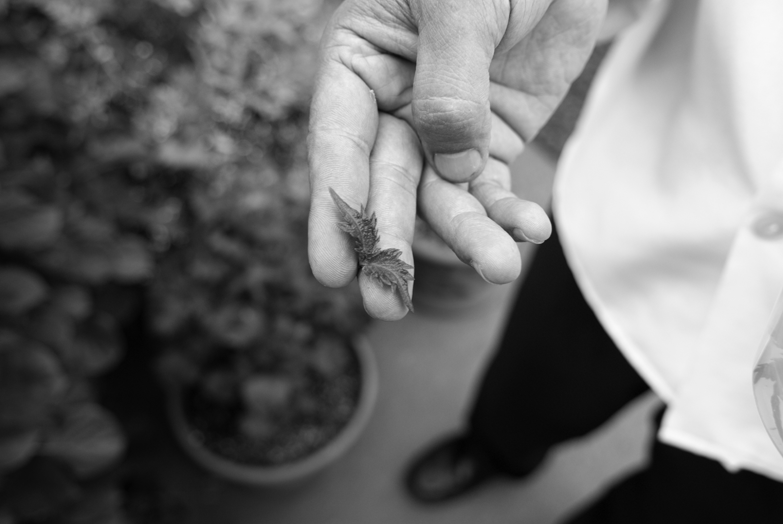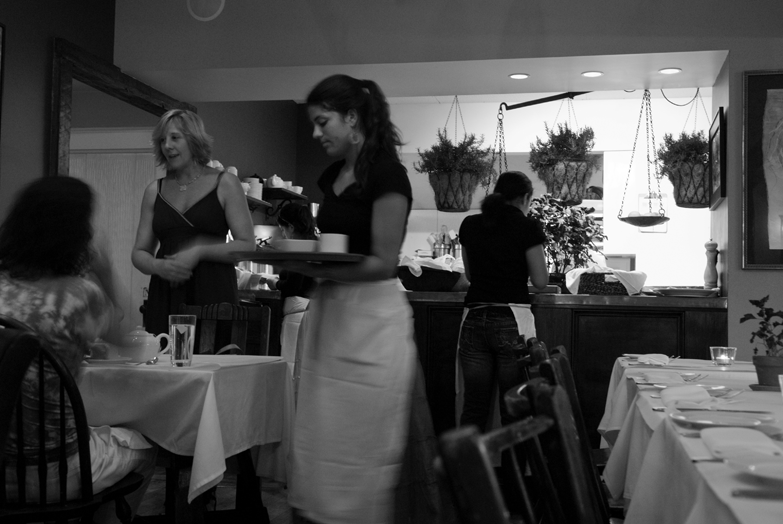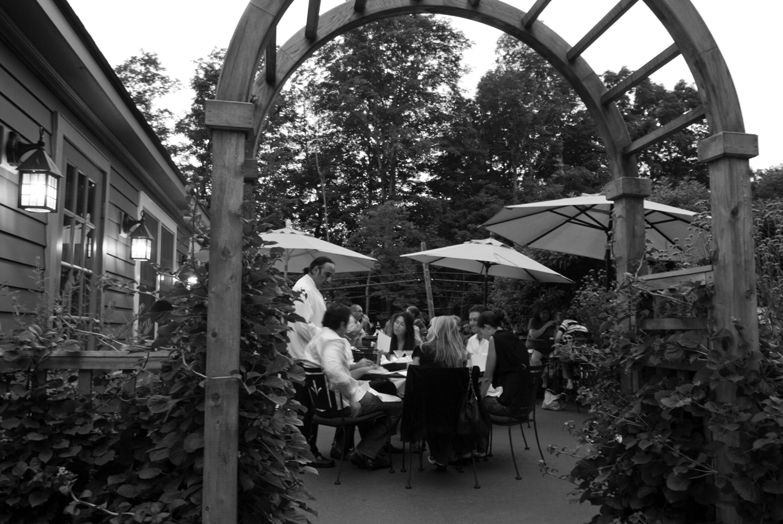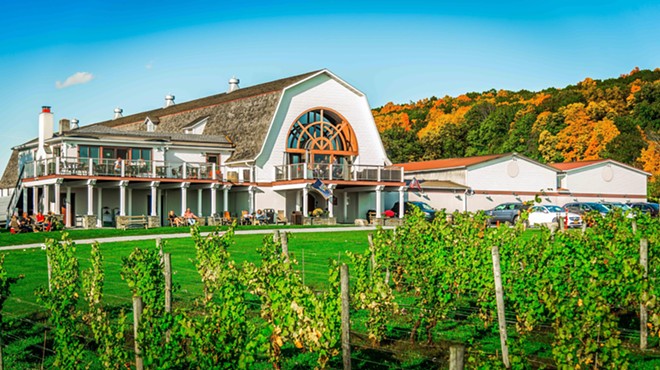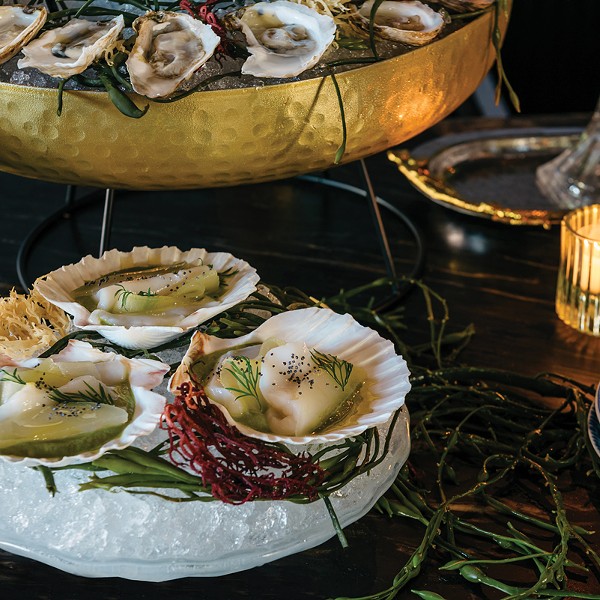Serevan, in spirit, culinary charm, and humble nature, is more than a restaurant, a place to eat. It is an integral piece of the community, a spoke in the grand wheel of the Hudson Valley. The beauty and distinctiveness of Serevan lies in its historical charm and architectural finesse—living, breathing entities that have been gently cultivated by an Armenian from Tehran, chef and proprietor Serge Madikians.
Serevan’s location in Amenia (which is derived from the Latin word amoena, meaning “pleasing to the eye”) is quintessentially picturesque farm country: rolling green hills, horse farms by the dozen, and far removed from strip malls. Serevan is housed in a former farmhouse that was built in the 1880s. Over the years, it’s been a bar, a brothel (what establishment of a certain age hasn’t?), the scene of an unresolved murder (ditto previous comment), and more recently, an Italian restaurant.
When Madikians came onto the scene, he transformed the dwelling and grounds into a lush, gastronomical oasis. Windows were replaced, the entrance relocated, and the surrounding walls reinforced. Inside, some of the original floors and overhead beams were exposed and refurbished. The walls were painted in colors that kept history and nature in mind—a rich Sherwood green and a warm, deep Van Deusen blue—and adorned with local artwork. On each table are small potted herbs, and baskets of fresh rosemary hang from the walls of the open kitchen; both are utilized for cooking. In the restaurant’s main dining room, not unlike a typical living room, the fireplace mantle is full of family photos, including Madikians’s grandfather, a particularly strong source of inspiration and strength for him. The elder Madikians survived the Armenian genocide, an escape to Iran, two political imprisonments, and still managed to start a family. With other family members in 1937, he opened Café Naderi, which is still in the family and was recently declared a historic site by the Iranian government.
Outdoors, tables are set up on a charming patio, screened off from the road by a variety of plants and herbs, including smoke bushes and red cabbage, Japanese willow, verbena, and several types of edible flowers. In the back, the flower, herb, and vegetable garden includes (to name a few) Persian tarragon, thyme, curry, oregano, pineapple sage, pineapple mint, Thai basil, shiso, five kinds of cucumbers, green beans, tomatoes, nasturtiums, squash blossoms, zucchini, and Swiss chard. To understand Serevan is to understand the elements of Madikians’s garden, and how it addresses the cycles of nature—a process that ultimately instills in him a sense of humility and, at the same time, gratification.
“The closeness I feel with the earth, my own vegetables and their needs, really compels me to understand, respect, and better appreciate them.” Madikians believes his job is “to have a visceral dialectic with the ingredients.” In other words, to “listen to the ingredients rather than imposing my will on them. They will tell you what they want.”
This all makes perfect sense when you consider Madikians’s collaboration with local farmers and understanding of how farmers operate within natural constraints. Madikians is cognizant of “how [farmers] have to work with the forces of nature to be able to produce their own harvests.” Combine this with his apprenticeship with some of the best chefs in the world, including David Bouley and Jean-Georges Vongerichten, his background in music, his education in history, philosophy, and dance, and you can understand how his holistic view of creating beautiful food has brought him to where he is today.
The California- and New York City-schooled student of urban planning and economics made his way to the Hudson Valley after attending the French Culinary Institute in Manhattan and working at celebrated venues like Jean Georges, Monkey Bar, Bouley Bakery, and Danube, eventually taking the executive chef job at Chez es Saada. Additional stints followed in both New York City and California until the spring of 2002, when he became executive chef at Main Street Bovina in the Catskills. Subsequently, Madikians stayed at, and visited several towns in the Hudson Valley and further upstate, looking for a place that would enable him to be part of, and closer to, the cycle of life—before finding Amenia, which “spoke to him” unlike anywhere else he had been. Though educated, experienced, and urbane, it was as if Madikians had begun anew. The abundance and cycles of nature that only the country could provide ignited his deepest artistic sensibilities, and so Serevan, named for a bird found on the Ile de France in the 18th century, was born.
Dinner at Serevan is an affair. Madikians walks around to each and every table, talking, listening, accommodating requests. He bobs and weaves between the kitchen’s hot and cold stations, joining and assisting his young but well-trained staff, including sous chef Ian Wright, as they attend to a full house of guests. Or maybe Madikians is inspecting plates—wiping, adjusting, garnishing, making each one just right; or he’s pairing a wine with a guest’s meal. Then, on their way out, diners make a point of saying good-bye, and all are wished well “until the next time.” It’s Madikians’s philosophy that patrons and staff are like family and should be treated accordingly.
The dishes at Serevan are greatly influenced by Mediterranean, Persian, and Moroccan elements. Madikians impressed on me his attraction to “the dance” of sweet, sour, and salty taste combinations that create an exquisitely balanced sensation for the palate. Entrees often include dried, grilled, roasted, or pureed fruits or vegetables; many fresh herbs like tarragon, several kinds of mint, dill, thyme; preserved lemons; limes; couscous; lentils; free-range meats; and freshly caught seafood. As with all the best cuisines of the world, Serevan’s food is not based on complexity. It’s quality. Use the best, the freshest, and make it yourself; keep it local and seasonal, and the result is simply good food.
At Serevan, each dish has a wide range of appeal. The menu, while keeping some favorites on hand, changes weekly—consistently making accommodations for the cycles of the season and supply of ingredients. Take a look at this small sampling: Couscous crusted Chatham cod with arugula, seared watermelon, and fresh mint. Ground lamb tart, spinach puree, harissa (Moroccan hot sauce), and curried labne (yogurt cheese). Poached shrimp, fresh oysters, roasted corn, spicy watermelon, and organic micro greens. Organic yogurt soup, barley, black currants, fresh herbs, and curry oil. Warm squid salad with capers, Granny Smith apples, cauliflower, and fresh dill.
For starters, I tried an organic roasted red beet salad with orange sections, pistachios and pistachio oil, arugula, and Greek feta, as well as chilled green pea soup with pineapple mint, tarragon, chanterelles, and mussels, splashed with Aleppo chile pepper oil. The pea soup was delicious, and I wish I didn’t have to say it like this, but it really was minty fresh. It also had a nutty, musky flavor; it was creamy, buttery, and salty, which carried the flavor of the sweet mussels perfectly. The beet salad was sweet and enjoyable. The scarlet hue of the beets, the brilliant color of the orange sections, combined with the greens and tangy feta were a clever combination of flavors and colors.
For entrees I sampled a lamb stew with lime, dates, fresh herbs, and basmati rice as well as the couscous-crusted Chatham cod. The lamb was deftly done, combining the tender and sweet of the meat in a rich, cinnamon-infused base with a zing of lime. The rice was delicate and delightfully prepared. The cod was incredibly moist, encased beautifully in a crunchy couscous blanket. The peppery arugula played nicely against the sweetness of the watermelon—which tastes more like a tomato when grilled.
All the desserts at Serevan are house made. I had what only could be had: the chocolate apricot sticky toffee cake with chocolate caramel sauce and orange ice cream. Yes, it was that good.
I also tried the flourless pistachio chocolate cake with pistachio ice cream. It probably would have been wiser to go with a fruit-type dessert to contrast the richness of the toffee cake, but nonetheless, it was delish—moist and dense but not too heavy. And the creamy pistachio ice cream was the perfect match.
If he’s not growing it in his own garden, Madikians makes a concerted effort to buy seasonally—and organically when possible—from several local farmers, for his greens, vegetables, herbs, meats, and poultry. Some of them include Miglioreli Farms in Tivoli, Madrose in Smithfield Valley, and Sky and McEnroe farms, both in Millerton. And of course, there are the excursions to the city twice a week for specialty items and fish from the market.
Though not outrageous, Serevan is not inexpensive. Entrees run from the mid $20 range to $36; appetizers $8 to $12. Desserts are $7. There is a full bar and a compelling selection of reasonably priced wines, mostly French and Italian, which Madikians finds conducive to, and reflective of, his artesian, classic, Old World style of cooking.
Serevan, 6 Autumn Lane, Amenia, is open for dinner Thursday through Monday, 5 to 10pm. (845) 373-9800; www.serevan.com.








